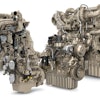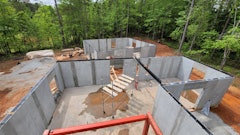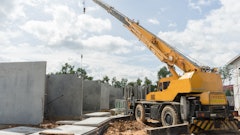
Command Alkon’s dispatch systems have been a staple in the industry for more than 40 years. In this competitive landscape, many ready mix operations are embracing cloud-based dispatch solutions to put their business ahead of the curve, and we’re right there with them.
Our approach isn’t simply taking our on-premise dispatch systems and hosting them in a cloud environment. Instead, we’ve made it our mission to build a solution that delivers immense value to the industry. When building something for the future, you have to involve those who have a heavy hand in what the future will look like. Any technology developer can hypothesize what sorts of challenges a dispatch team faces each day, but utilizing the power of questions and listening to our customers’ feedback has been paramount in understanding what bottlenecks stand in the way of dispatch operations and how we can help.
We spent several months traveling across the country to conduct interviews and get feedback on the true needs of the industry, and we have learned that some of their needs are: to have visibility into dispatch operations from anywhere, to simplify the complexities that an Order Taker, Scheduler, and Dispatcher deals with each day, and to enable multiple parties to access dispatch data so that they can make informed decisions.
Cloud Dispatch NOW – Improving Order Entry, Scheduling, Billing, and Operational Visibility
Pricing complexities from the time an order is entered causes challenges for the order taker. Having to calculate pricing and determine if additional materials are required while on the phone with a customer can be a lot to juggle. Dispatch improves speed in the order entry process by 33% with automated pricing, Sundry charges, and taxation. Most users average about 1 minute and 43 seconds to enter an order inside of Dispatch. Users can also add notes into each order so that everything that happens in the system is trackable and tells the entire story of what happened with the order.
Dispatch focuses on getting the most out of the key assets available to the company: plants, trucks, and drivers. Whether you are leveraging a plant-based, central, or hybrid model, Dispatch is mobile-first by nature and all of your dispatch data be accessed at any time from a web browser. Visualizations and planning tools within dispatch help to consider operational capacity and to create the best plan possible while also accounting for constraints. The power of Dispatch has helped customers to deliver over 270,000 tickets since it launched.
One of the biggest questions that a Dispatcher has is “can I meet this demand?” Not only do you have to consider if trucks are available, but you have to think about whether the plant has the time and resources to produce the materials. You can compare your order schedule against a visualization of how many trucks are available, as well as how many orders are already scheduled to determine when you need to schedule new orders. You want to be able to produce, load, and get the materials out the door within the timeframe that you told the customer you could do it. Having this insight helps you to determine if you can deliver on those promises. One of the planning workspaces can also help you to determine when drivers need to clock in and start their day. Scheduling can be automated and the system can make recommendations on who needs to be where and at what time.
Once an order is taken and scheduled, you have to keep track of it. The tracking window inside of Dispatch is borrowed from COMMANDtrack; the screen is familiar because Command Alkon customers have used the screen for decades. However, Dispatch enables additional functionality with the tracking screen. You can click on an order and dive into the details of that order so that you can be more transparent with customers about what phase in the delivery process the order is in. You can get deeper clarity into all orders without having to leave the tracking screen at all. Easy to access reporting from your plant(s) allows you to maximize the use of your production, dispatch, and office resources and to understand how your business is operating at any given time. The dashboards are configurable and can dig into information such as average batch load, batch accuracy per plant, typical production statistics, detailed driver summaries and performance, and more.
Not only is the order entry process quicker, but it’s more accurate. Each ticket that is delivered creates a billable record for the back office team to process. Removing the need to manually key order data and enabling the back office to edit ticket data and invoices leads to the ability to bill customers more accurately and reduce credits and rebills. With master data integration capabilities in place, you can easily maintain customers in your ERP system – Quickbooks, Viewpoint, Cyma, Keystone, and more – and share that data with dispatch to allow automation of credit, invoicing, billing, and accounts receivables. Since inception, over 95,000 orders have been billed with Dispatch. Today, we take priced tickets and export those to an ERP system. We understand that almost half our customer base invoices through Command Alkon systems, so we are currently working to add more master data integration capabilities to cloud Dispatch so that you have a better experience.
What Does FUTURE Cloud Dispatch Look Like?
We’ve built a dispatch system that helps to simplify the Order Taker’s job by reducing the volume of calls that they receive by improving their scheduling processes. Another way that we want to improve the Order Taker’s job is by utilizing machine learning, rather than creating a schedule from orders in the system based on the Scheduler’s tribal knowledge of the customer. Machine Learning (ML) is a field of Artificial Intelligence (AI) that uses statistical techniques to give computer systems the ability to "learn" from data – the more data, the better the insights. In the construction industry, data generated from transactions such as change orders, purchase orders, shipping notices, etc. can be fed into AI and ML engines to enhance decision-making. This way, the Order Taker, Customer Service Representative, and Logistics Manager can easily slide into the seat of a Scheduler if needed.
ML can take a set of orders and feed it into the dispatch model as they come in – similar to an initial phone call to place an order. The system then takes the same set of orders and inputs what the result of the orders actually were. Being able to take a look at historical orders and make predictions of which customers will cancel the orders helps when it comes to making decisions on the best way to leverage assets, schedule drivers, replenish raw materials, and coordinate third-party trucks. It can also help to determine if customers are making orders accurately, if they give enough heads up when there is an order change, if there is sufficient trucking, and if customers are paying in a timely manner.
Using ML in association with customer behavior will eventually enable you to profile “good” and “bad” customers and score them based on order confidence. If a customer is constantly canceling orders or making change requests, you can prioritize customers that you know will follow through with orders and even have the opportunity to charge for timeslots (similar to an airline) for “premium” order fulfillment timeslots. If you are able to determine which customers pay invoices on time, you are better able to figure out how much you’ve added to your bottom line each month.
Interested in learning more about our cloud-based Dispatch solution? Visit www.commandalkon.com/dispatch.



















